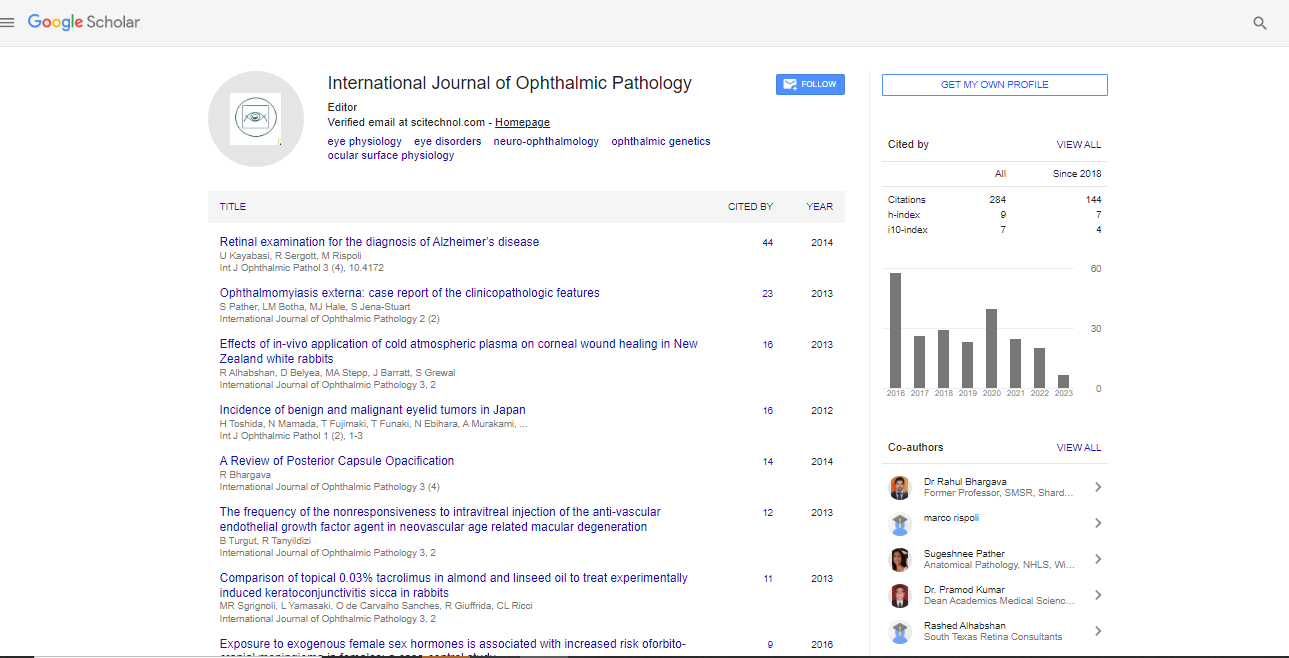Commentary, Int J Ophthalmic Pathol Vol: 0 Issue: 0
Intra-Operative Measures to Minimize the Surface Damage of the Eye
Charles Smith*
Department of Ophthalmology, Rollins School of Public Health, Emory University, Atlanta, USA
*Corresponding Author: Charles Smith
Department of Ophthalmology, Rollins School of Public Health, Emory University, Atlanta, USA
E-mail: Smithc@gmail.com
Received: August 03, 2021 Accepted: August 17, 2021 Published: August 24, 2021
Citation: Smith C, 2021, Intra-Operative Measures to Minimize the Surface Damage of the Eye. Int J Ophthalmic Pathol, 10:8. (294)
Abstract
According to the incidence of dry eye in patients scheduled to undergo cataract surgery in a real-world setting is higher than anticipated. In this observational investigation, it is tracked down that about 77% of the eyes have positive corneal staining, 60% have tear film separate season of ≤ 5 seconds, and 21% have Schirmer's scores of ≤ 5 mm. Most of patients didn't report side effects that are reminiscent of dry eye.
Keywords: Dry eye, Intra-Operative
Introduction
According to the incidence of dry eye in patients scheduled to undergo cataract surgery in a real-world setting is higher than anticipated. In this observational investigation, it is tracked down that about 77% of the eyes have positive corneal staining, 60% have tear film separate season of ≤ 5 seconds, and 21% have Schirmer's scores of ≤ 5 mm. Most of patients didn't report side effects that are reminiscent of dry eye. As well as prior dry eye, waterfall medical procedure brings out the visual surface or makes asymptomatic dry eye indicative. The etiology is multifactorial and identified with corneal nerves analyzation, surface epithelium disturbance and aggravation. This is normally apparent postoperatively by visual distress and change of vision. The point of this article is to survey the ebb and flow viewpoints in managing visual surface sickness in the setting of waterfall medical procedure and expanding patient fulfilment postoperatively. The presence of solid visual surface before waterfall medical procedure isn't just vital for post-usable patient solace, yet additionally influences the IOL computation and postoperative visual capacity [1].
Intra-operative Measures
An assortment of variables in the usable period adds to intensifying indications. Incessant organization of safeguarded preoperative and postoperative eye drops harm the epithelial surface. The corneal cuts made at the hour of medical procedure disturb the criticism instrument that animates the lacrimal organ by the corneal nerves. Delayed openness to the magnifying instrument's light, forceful water system of the tear film and incessant effective sedative upon the arrival of medical procedure all damage the corneal epithelium or potentially cause conjunctival mucous flagon cell misfortune. The utilization of light channels, diminished openness time, appropriate water system, and delicate control of the visual surface tissue might decrease confusions after medical procedure [2].
Post-operative Ocular Surface Care
The visual surface normally deteriorates after waterfall medical procedure. Contributing components incorporate corneal nerve interruption, postoperative aggravation and delayed utilization of additive containing skin drugs. In patients with surface sickness it is liked to stop or tighten prescriptions when as of now not required. Effective NSAIDs, for example, nepafenac, ketorolac and diclofenac have been accounted for to cause corneal liquefying for the most part within the sight of epithelial breakdown. Hence, in patients with critical visual surface sickness, it is judicious to limit or even stay away from the utilization of effective NSAIDs particularly as a solitary specialist, normally in blend with effective steroids. Expanding proof recommends the viability of a blend of effective greases and effective cyclosporine for long haul visual surface support. Cyclosporine 0.05% treatment twice every day for 90 days has been accounted for to lessen dry eye signs and further develop visual quality get-togethers medical procedure [3]. It is shown pre-and postoperative treatment with skin cyclosporine 0.05% reduces dry eye signs, work on visual results, and improve the fulfillment of patients going through waterfall medical procedure with multifocal IOL implantation. Ocular surface disease frequently goes undiagnosed in the setting of cataract surgery specially when the patients are asymptomatic. Diagnosis and management of ocular surface disease in cataract patients will help to achieve better visual outcome and patient satisfaction postoperatively [4].
References
- Cha SH, Lee JS, Oum BS, Kim CD (2004) Corneal epithelial cellular dysfunction from benzalkonium chloride (BAC) in vitro. Clin Experiment Ophthalmol 32: 180-184.
- Chuang J, Shih KC, Chan TC, Wan KH, Jhanji V, et al. (2017) Preoperative optimization of ocular surface dis ease before cataract surgery. J Cataract Refract Surg 43: 1596-1607.
- Kasetsuwan N, Satitpitakul V, Changul T, Jariyakosol S (2013) Incidence and pattern of dry eye after cataract surgery. PLoS One 8: e78657.
- Wolf EJ, Kleiman LZ, Schrier A (2007) Nepafenac-associated corneal melt. J Cataract Refract Surg 33: 1974- 1975.
 Spanish
Spanish  Chinese
Chinese  Russian
Russian  German
German  French
French  Japanese
Japanese  Portuguese
Portuguese  Hindi
Hindi 